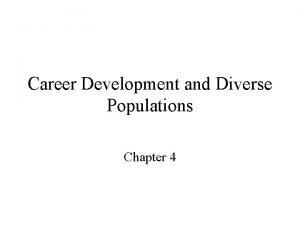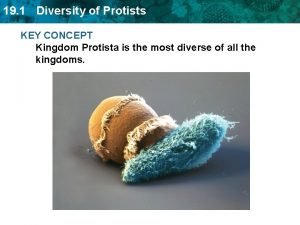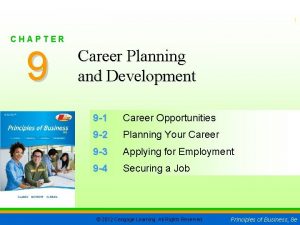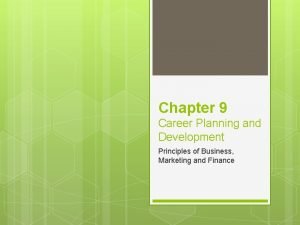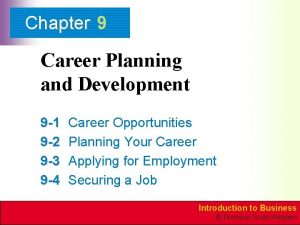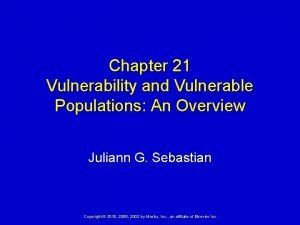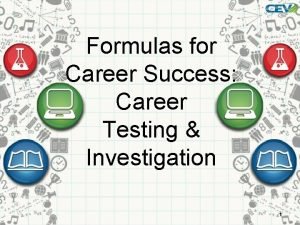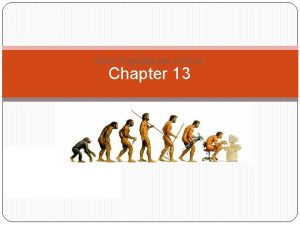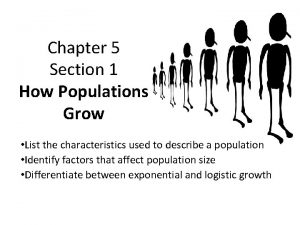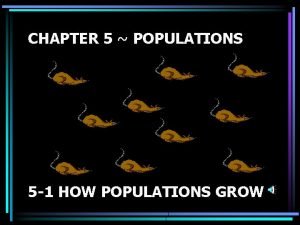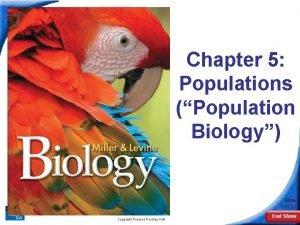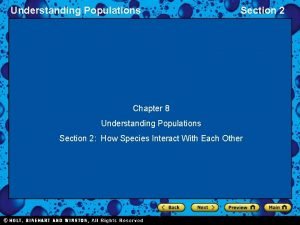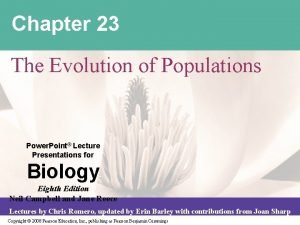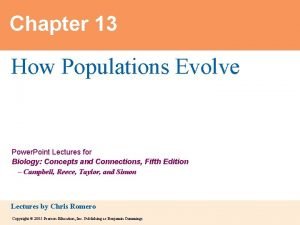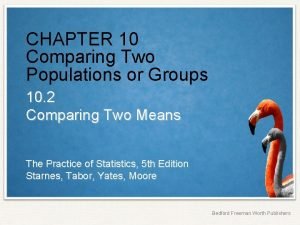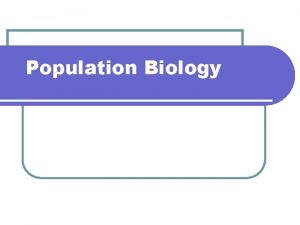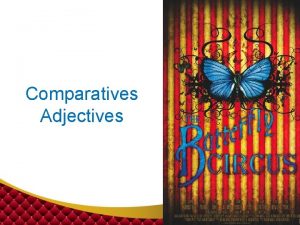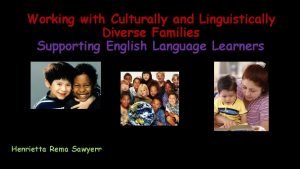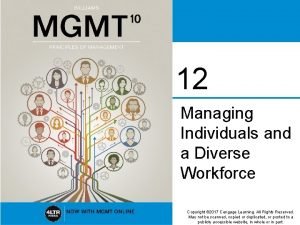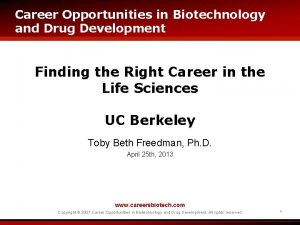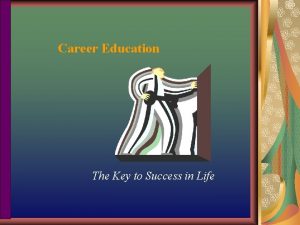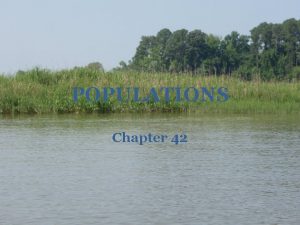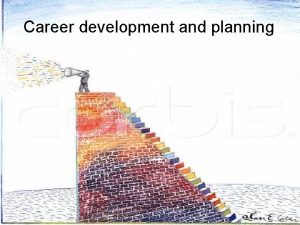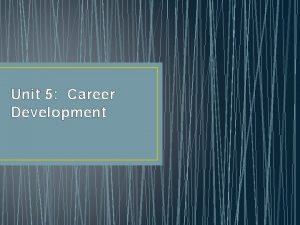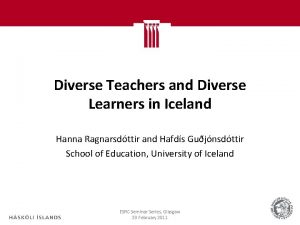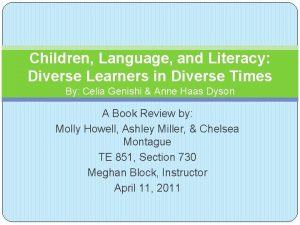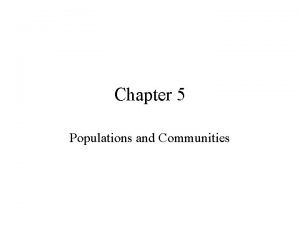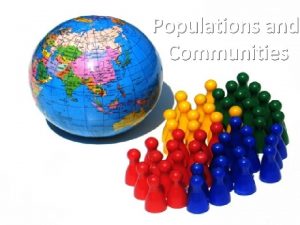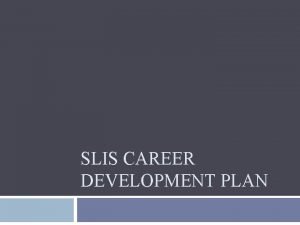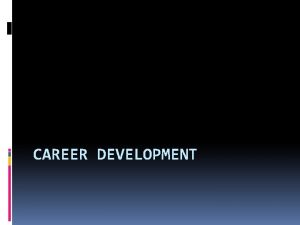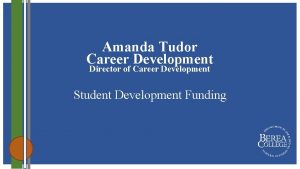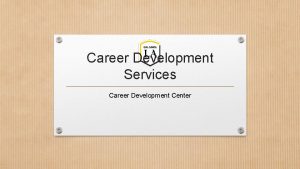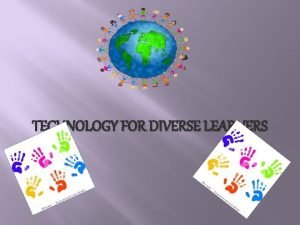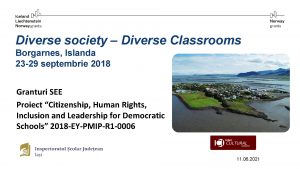Career Development and Diverse Populations Chapter 4 Definition




























- Slides: 28

Career Development and Diverse Populations Chapter 4

Definition of Multicultural Counseling • A helping process that places the emphasis for counseling theory and practice equally on the cultural impression of both the counselor and the client (Axelson, 1985)

Predictions by Johnston and Packer • Average of workforce will rise while the pool of young workers will decrease. • More women will enter the workforce. • Minorities will make up a larger share of the new entrants into the workforce. • Immigrants will make up the largest share of increase in the population and workforce since World War I.

Some Basic Facts • Unemployment rate for African Americans has been above 11% each year since 1978 (2 1/2 times the rate for Whites). • Only 36. 9% of African American men are employed as executives, administrators, salespersons, and managers (compared to 61. 8% for White men).

Some Basic Facts, continued • More than half of employed Hispanic women are clerical workers or operatives. • Poverty rate of Native Americans is twice (23. 7%) that of the general population. • Men are 18. 7 times as likely to be in higher prestige occupations in science, math, or technology than women. • Only 33. 6% of persons with disabilities are in the workforce.

American Assumptions • • • Individualism and autonomy Affluence Opportunity open to all Centrality of work in people’s lives Linearity and rationality of the career development process

Universal or Culture-Specific Models? • Etic perspectives - maintain that career interventions for members of minority groups should be the same as those used for the majority. • Emic perspectives - highlight the importance of offering career development interventions that are specific to the client’s culture.

Universal Elements of Healing in All Cultures (Fischer et al. ) • • The therapeutic relationship Shared worldview Client expectations Ritual or intervention

Acculturation • The process of adopting the cultural traits or social patterns of another group (Stein, 1975) • Language familiarity and usage, cultural heritage, ethnicity, ethnic pride and identity, interethnic interactions, and interethnic distance influence acculturation (Padilla, 1980) • Persons may be marginal (not accepting either culture fully) or bicultural (accepting both fully)

Racial Identity Models • Models of racial identity help us understand that the status of racial identity -- for both counselors and clients -- can influence the career intervention process at several levels.

Using Assessment • Must assure that assessment is valid, reliable, and appropriate for the client’s cultural and linguistic context. • Must assure that the test does not have cultural bias.

Five Stages of Racial Identity Development (Atkinson, Morten, & Sue) • • • Conformity Dissonance Resistance and immersion Introspection Synergy

Cross Model • • • Pre-encounter Encounter Immersion-Emersion Internalization-Commitment

Gender Differences in Socialization • Stereotypically reinforce competition and skill mastery in boys, relationships and connectedness in girls • Affect initial selection of occupation and opportunities for mentoring and promotion

Feminist Identity Model (Gysbers, Heppner, & Johnson) • • • Stage 1: Passive Acceptance Stage 2: Revelation Stage 3: Embeddedness-Emancipation Stage 4: Synthesis Stage 5: Active Commitment

Special Needs of Women (Cook, Heppner, & O’Brien) • Dealing with attending to the needs of others • Learning to negotiate in the workplace • Accessing quality child care • Handling sexual harassment in the workplace • Accessing mentors

Special Needs of Men • Understanding how socialization has influenced their career behaviors • Learning to express feelings • Learning how to manage and reduce stress • Identifying strategies to participate more fully in life roles other than work

Four-Stage Model of Lesbian Identity Development (Sophie) • Stage 1: Awareness of homosexual feelings without disclosing these to others • Stage 2: Testing and exploration of emerging homosexual identity with limited disclosure to heterosexuals • Stage 3: Identity acceptance and preference for gay social interactions • Stage 4: Identify integration with movement from a dichotomous (homosexual, heterosexual) worldview to integrated

Six-Stage Model of Identity Development for Gay Men and Lesbian Women (Cass, 1979) • • • Confusion Comparison Tolerance Acceptance Pride Synthesis

Five-Stage Model of Lesbian Identity Development (Chapman & Brannock) • Same-sex orientation -- feeling different about other females, but lacking a name for those feelings • Incongruence, social isolation, and confusion about heterosexual dating • Self-questioning and exploration with strong bonds with other females • Identification as lesbian • Choice of lifestyle -- woman as long-term mate or not

Definition of Persons with Disabilities • One who is usually considered to be different from a normal person -- physically, physiologically, neurologically, or psychologically -- because of accident, disease, birth defect, or developmental problem (Herr & Cramer, 1996)

Another Definition • A person who has physical or mental impairment that substantially limits one or more major life activities, or has a record of such impairment, or is regarded as having such an impairment (Americans with Disabilities Act, 1990)

Americans with Disabilities Act • Employers can only consider essential job functions when hiring or promoting. • Employers must make reasonable accommodations in the workplace.

Career Development Issues of Persons with Disabilities (Zunker, 1998) • • • Adjusting to disability Confronting attitudinal barriers Lack of role models Developing social/interpersonal skills Developing a positive self-concept Developing skills for independent living

Competencies for Working with Persons with Disabilities • Interpret and advise about legislation, policy, guidelines, and rights • Use diagnostic and informal assessment • Assess functional limitations and adapt methods of occupational exploration • Apply theory to assist with analysis of selfconcept or developmental tasks deficits

Competencies for Working with Persons with Disabilities, continued • Engage in effective individual and group counseling • Team with other specialists for career planning and placement • Work with employers to develop or restructure jobs • Plan and implement skill-building workshops or experiences

Components of Culturally Sensitive Career Interventions (Herr & Kramer) • Possession of knowledge and skills appropriate in any helping relationship • Recognition of personal attitudes and values • Knowledge of cultural context from which clients come • Ability to identify special needs

Components of Culturally Sensitive Career Interventions, continued • Ability to assist culturally different clients understand that they do have choices, some of which include consequences. • Skill to assist culturally different individuals to deal effectively with discrimination when it does occur • Skill to discern between client deficits that result from socioeconomic class and those from membership in a racial or ethnic group
 Career development of diverse populations
Career development of diverse populations Cellular vs plasmodial slime molds
Cellular vs plasmodial slime molds Chapter 9 career planning and development
Chapter 9 career planning and development Chapter 9 career planning and development
Chapter 9 career planning and development Chapter 9 career planning and development
Chapter 9 career planning and development Chapter 21 vulnerability and vulnerable populations
Chapter 21 vulnerability and vulnerable populations Chapter 16 section 2 transcaucasia
Chapter 16 section 2 transcaucasia 17 career clusters
17 career clusters Formulas for career success: résumés - assessment
Formulas for career success: résumés - assessment Chapter 16 evolution of populations vocabulary review
Chapter 16 evolution of populations vocabulary review Chapter 13 how populations evolve test
Chapter 13 how populations evolve test Chapter 17 evolution of populations answer key
Chapter 17 evolution of populations answer key 5-1 how populations grow
5-1 how populations grow 5-1 how populations grow
5-1 how populations grow Chapter 23: the evolution of populations
Chapter 23: the evolution of populations Chapter 16 evolution of populations
Chapter 16 evolution of populations Chapter 10 comparing two populations or groups answer key
Chapter 10 comparing two populations or groups answer key 5-1 how populations grow
5-1 how populations grow Chapter 8 understanding populations
Chapter 8 understanding populations Chapter 23 the evolution of populations
Chapter 23 the evolution of populations Chapter 13 how populations evolve
Chapter 13 how populations evolve Chapter 10 comparing two populations or groups
Chapter 10 comparing two populations or groups Population biology definition
Population biology definition Diverse comparative and superlative forms
Diverse comparative and superlative forms Working with culturally and linguistically diverse families
Working with culturally and linguistically diverse families Vanier institute of the family definition
Vanier institute of the family definition What is deep level diversity
What is deep level diversity Career opportunities in biotechnology and drug development
Career opportunities in biotechnology and drug development Lynn thier
Lynn thier
